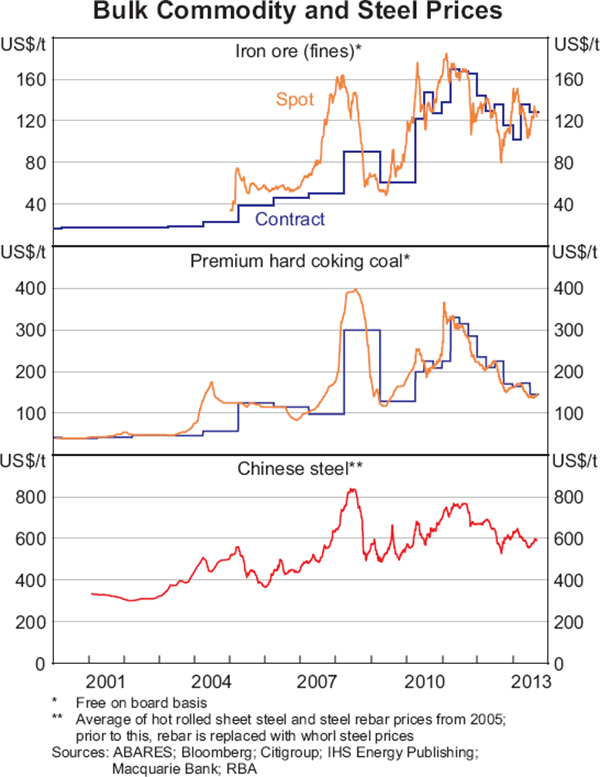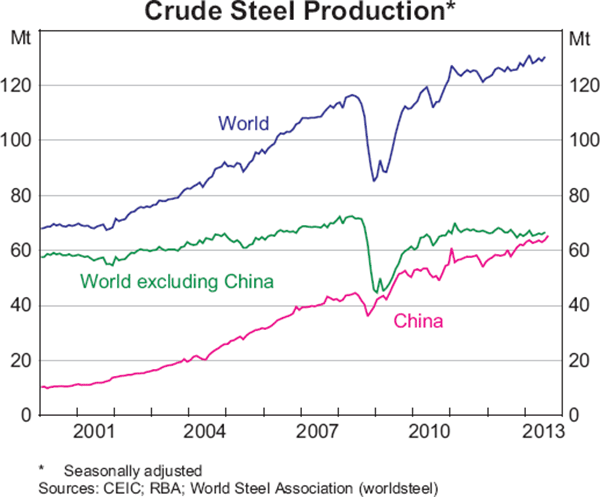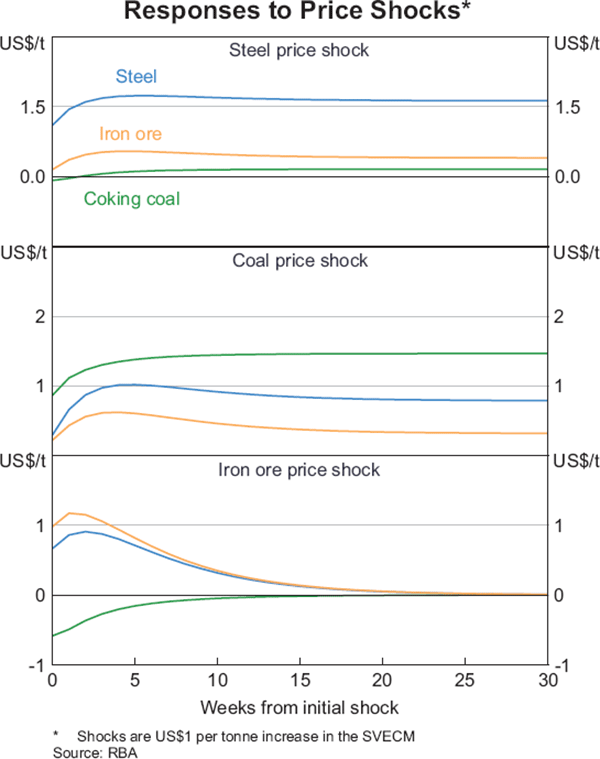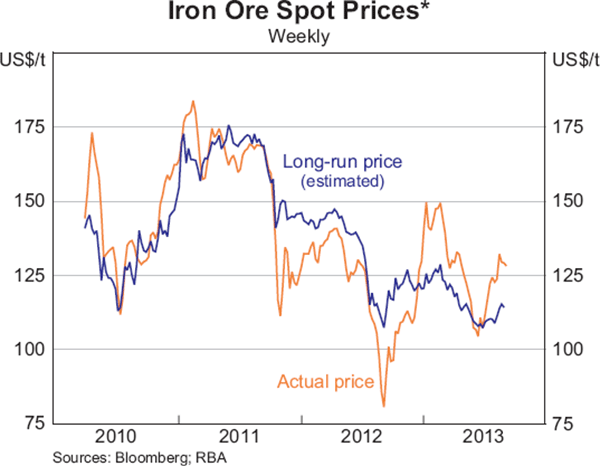Bulletin – September 2013 Global Economy The Relationship between Bulk Commodity and Chinese Steel Prices
- Download the article 614KB
Abstract
Iron ore and coking coal are complementary inputs for steelmaking and therefore their prices are closely related to steel prices. Historically, trade in iron ore and coking coal was based on long-term contracts, but in recent years there has been a shift towards shorter-term pricing, including on the spot market, and consequently prices reflect market developments more quickly. This article analyses the relationship between the spot prices for iron ore, coking coal and Chinese steel products, and finds that in the short run the spot price for iron ore has tended to overshoot its long-run equilibrium following an unexpected change in Chinese steel prices.
Introduction
Bulk commodity prices have risen over the past decade as China has industrialised and urbanised. The prices of iron ore and coking coal – which currently account for one-quarter of the value of Australia's exports – are around four times higher than they were in the early 2000s (Graph 1). These increases have resulted in a considerable rise in Australia's terms of trade. Over this period, iron ore and coking coal have been increasingly traded either on the basis of short-term contracts or at spot prices, both of which are influenced by developments in the Chinese steel market.

The expansion in China's consumption and production of steel has been a key driver of the increase in demand for iron ore and coking coal, both of which are used predominantly as inputs for steelmaking (Graph 2).[1] The commonly used blast furnace/basic oxygen converter method of producing crude steel requires on average around 1.4 tonnes of iron ore and 0.8 tonnes of coking coal to produce a tonne of steel (World Steel Association 2011). This implies a close relationship between fluctuations in the prices of domestic Chinese steel and the prices of iron ore and coking coal. Indeed, these prices have experienced similar cycles in recent years. In 2007/08, there was a run-up in prices, underpinned by strong growth in China, which was followed by a sharp decline, reflecting the downturn in global economic activity associated with the onset of the global financial crisis. Demand for steel increased over 2009/10, due to the policy stimulus and associated rise in infrastructure spending in China, resulting in significant increases in prices of steel, iron ore and coking coal. Prices peaked in 2011 as severe flooding in Queensland temporarily disrupted the supply of Australian coking coal. In recent years, prices have trended lower as additional supply of iron ore and coking coal has become available and growth in Chinese crude steel production has moderated.

This article examines the relationship between the prices for iron ore, coking coal and Chinese steel. It seeks to estimate, and hence disentangle, the temporary from more persistent components of these price movements.
Data
Bulk commodity prices
Iron ore and coking coal are sold internationally in over-the-counter (OTC) markets where individual transaction details are not readily observable and individual characteristics of different sources of coal and iron ore (such as purity and moisture content) can require specifically tailored contracts. Until the mid 2000s, trade in iron ore and coking coal was largely based on longer-term contract prices. In recent years, however, trade of these commodities has shifted to shorter-term pricing mechanisms and this has coincided with Chinese imports growing strongly. The initial move was from annual to quarterly contracts in the first half of 2010, and over recent years to monthly contracts and spot sales. Arguably, spot transactions are now the most informative signal about the current state of demand and supply for iron ore and coking coal. Nevertheless, there is no single measure of the spot price for these commodities. Spot prices for iron ore and coking coal are published by various private sector data providers, including Platts, The Steel Index (TSI), Metal Bulletin and IHS Energy Publishing. Prices are based on transaction, bid and/or offer data submitted from market participants such as mining companies, steel producers and brokers. Although there can be small differences in the methods employed and the data sources collected, most comparable benchmark spot prices appear to move closely with each other.
The importance of shorter-term pricing is most evident in the iron ore market. Monthly contract prices and spot transactions account for a large share of global trade (RBA 2012). For example, Australia and Brazil are by far the two largest exporters of iron ore, and more than half of their exports of iron ore are estimated to be sold using short-term index-based approaches (equivalent to more than 450 million tonnes per year, or close to 40 per cent of global iron ore trade). Chinese buyers are large participants in this market. The remainder of iron ore trade tends to be based on longer-term contracts, typically of quarterly duration, where the price is linked to previous spot price outcomes. A number of Japanese steel mills reportedly prefer this pricing arrangement. In contrast, the shift toward shorter-term pricing has been less marked for coking coal, in part reflecting its more varied physical characteristics and China's proportionally smaller share of world imports. Important physical characteristics include the amount of fixed carbon, volatile matter, ash, sulphur and moisture. These properties affect the performance of coal in steelmaking and energy generation and its ability to be transported. Sales based on quarterly contract prices are presently estimated to account for around two-thirds of the global trade in coking coal. Nevertheless, the use of shorter-term pricing for coking coal has gained prevalence since late 2011, with market reports suggesting that the remainder is sold using monthly contracts or spot transactions.
The spot price for iron ore imported into China by sea is the most commonly used reference price for the physical sale and purchase of iron ore, although multiple variants are published. Typically, the benchmark spot price is quoted in US dollars per dry metric tonne, for 62 per cent iron content (which is comparable to the average quality of iron ore exported from Australia) and stipulates whether it includes the cost of freight and/or insurance. Published spot prices usually also control for other physical characteristics, such as the level of impurities and moisture, and extreme or unusual price movements are reportedly removed.[2] The cost of shipping is also standardised to delivery to one of China's major north-eastern trading ports.
Although there are a range of spot prices for different types of coking coal, the spot price for premium low-volatile hard coking coal from Queensland is typically regarded as a benchmark spot price, with around 60 per cent of Australia's coking coal exports having somewhat similar physical characteristics. Based on Energy Publishing's methodology, the spot price index is measured on a free on board basis and includes only once-off deals that are not explicitly or implicitly associated with any past or future contracts (Energy Publishing 2010).
Chinese steel prices
China is presently the world's largest producer and consumer of steel, accounting for close to half of global production. Around one-half of China's steel consumption is used for construction and building infrastructure while the other half is used for manufacturing that is both exported and used domestically (Wu 2009). The prices of steel products sold in China tend to move together quite closely, although they can diverge periodically due to idiosyncratic factors. One indicator of domestic steel prices in China that is being used in this paper is the average price of steel reinforcing bar (rebar) and hot rolled sheet steel sourced from Bloomberg; these products are used extensively in the construction and manufacturing industries, respectively. The relatively competitive Chinese steel industry should aid the price discovery process for steel.
Modelling the Relationship
To examine the relationship between the spot prices for iron ore, coking coal and Chinese steel, a structural vector error correction model (SVECM) is estimated, covering the period between April 2010 and August 2013 using weekly data.[3] This approach allows us to jointly model all three prices while integrating both their long- and short-term determinants. While relatively short, the sample starts in 2010 and covers only the period when spot prices have become indicative of the marginal tonne sold and therefore the relationship between steel, iron ore and coking coal prices is more likely to be stable.
Steel, as discussed above, is produced using relatively fixed proportions of iron ore and coking coal. Consequently, its marginal cost of production should be a linear combination of the prices of iron ore and coking coal. The price of steel can be thought of as being a mark-up on these costs. Statistical tests suggest that none of the three prices display mean reversion, but that the mark-up of the price of steel on costs does. More formally, the prices appear to be non-stationary, but there is one cointegrating relationship between them. The SVECM approach allows such a relationship to be incorporated into a model:

where y denotes the vector for the endogenous variables, namely Chinese steel prices and the spot prices for coking coal and iron ore; Δ denotes the first difference, and B, c, α, β and T are all parameter matrices and vectors. ∈ are the structural shocks.[4]
There are several aspects to note about this model. First, it is comprised of three equations, one for each price. However, the model also allows for contemporaneous relationships between all of these prices, which are captured by the B matrix. The structure of this B matrix is important and is discussed in more detail below. Second, the determinants in the change of these prices are lagged changes in the prices (captured by the TΔyt−1 terms; note that T is a matrix of coefficients; longer lags yield qualitatively similar results), and the long-run relationship. The latter is also known as an error correction term, which is a linear combination of the three prices denoted by β′yt−1, where the vector β contains the parameters. α is a vector comprised of the parameters on the error correction term in each of the equations. Finally, unexplained fluctuations in the prices are summarised in ∈ the structural shocks.
Identification
In order to interpret the effects of a given type of shock, for example a demand or supply shock and whether transitory or permanent, some model parameters need to be restricted. These restrictions are also referred to as identifying assumptions and are guided by the expected behaviour of the variables.
The first restriction we place is to normalise a coefficient on one of the contemporaneous variables in each equation, which allows us to refer to a ‘Chinese steel price’ equation, a ‘coking coal price’ equation, and an ‘iron ore price’ equation (in other words, the diagonal of the B matrix is normalised to be 1). Second, based on cointegration tests, only one cointegrating relationship is assumed to exist and is included in the model. This assumption implies that two of the shocks (elements of ∈) have permanent effects, that is, these shocks change the level of at least one of the prices in the long run. Pagan and Pesaran (2008) demonstrate that equations which have a permanent shock do not contain the error correction term, that is, its element of α is zero. Consequently, an approach to identification of the model is to select which of the shocks are permanent, and to place further restrictions upon the contemporaneous relationships between the prices.
A common approach might be to assume that shocks to Chinese steel prices reflect unanticipated changes to steel demand and therefore are transitory, whereas shocks to the spot prices for coking coal and iron ore reflect changes in supply, and therefore are long lasting. However, as China is industrialising rapidly, which has underpinned the growth in demand for these products, this approach seems less applicable. Instead, we assume that shocks to steel prices can have a permanent effect. The second permanent shock could be supply related in either the iron ore and coking coal sectors; it is assumed to appear only in the coking coal price equation, with shocks to the equation for the relatively volatile spot price for iron ore transitory in nature.
In the short run, coking coal prices are assumed to not respond to Chinese steel prices contemporaneously, motivated by the relatively low share of coking coal traded on the spot market.[5] The model yields qualitatively similar results for a range of alternative identifying assumptions.
The estimation is done in two steps. The long-run relationship is first estimated using ordinary least squares (OLS), and then given this each of the equations is estimated individually using instrumental variables, following the approach of Pagan and Pesaran (2008).[6]
Results
Graph 3 shows the responses of the endogenous variables to shocks. Overall, the prices tend to react quickly to the shocks, although there appears to be some overshooting for the spot price for iron ore, and to some extent for Chinese steel prices, as these prices increase by more than their eventual level immediately after the shock. In comparison, coking coal prices converge gradually to their long-run level, though the coking coal price equation has limited ability to fit the data.

Considering the specific shocks in Graph 3 in turn, the top panel shows the response to an unanticipated US$1 increase in the price of Chinese steel. This shock results in higher prices of coking coal and iron ore, which subsequently increase steel prices further in the long run. At the sample mean, an unexpected 1 per cent increase in the spot price for Chinese steel is estimated to increase the spot prices of iron ore and coking coal in the long run by 1¼ and ¼ per cent, respectively (in the short run, the spot price for iron ore is estimated to increase by up to 1½ per cent). Turning to other shocks, an unanticipated US$1 increase in the spot price for coking coal results in higher prices for iron ore and steel (Graph 3, middle panel). By assumption, iron ore price shocks do not have a long-run impact; however, a positive iron ore price shock results temporarily in higher Chinese steel prices, whereas coking coal prices decline for a time (Graph 3, bottom panel).[7] One interpretation of this shock is that it corresponds to a reduction in the supply of iron ore, and the resulting fall in the spot price for coking coal could therefore be due to a fall in its demand reflecting its complementary role with iron ore in steel production.
To disentangle more persistent shifts in the spot price for iron ore from temporary movements, the estimated value of the historical shocks can be used to construct a measure of the long-run price for iron ore.[8] For instance, the spot price for iron ore appeared to deviate significantly from its estimated long-run price when it moved sharply lower in late 2012 and higher in early 2013 (Graph 4).

Conclusions
Prices for iron ore and coking coal have risen significantly over the past decade owing to a large increase in steel production in China. In recent years, short-term pricing mechanisms – including spot transactions – have become increasingly important for global trade of these commodities. Using a model which allows prices to respond to each other endogenously, this article finds that the spot price for iron ore tends to react quickly and overshoot its long-run equilibrium value in response to an unanticipated increase in Chinese steel prices, whereas the price of coking coal responds more gradually.
Footnotes
The authors are from Economic Analysis Department. They thank James Hansen for helpful comments on an earlier version of this paper. [*]
Although crude steel can be produced from scrap steel (and other inputs) using electric arc furnaces, a relatively small proportion of steelmaking in China is currently fed from recycled scrap reflecting the low availability domestically of ferrous scrap and difficulties with the supply of electricity in some regions (Holloway, Roberts and Rush 2010). [1]
There are fallback procedures used by some data providers when there is insufficient information to compile a spot price. For instance, if this occurs, TSI reports that the new submitted transactions will first be complemented by the ‘rolling forward’ of transactions made during the previous period by data providers that have not submitted data in the current period. If the sample is still insufficient, bid and offer data may be used. In both cases, though, these fallback data will carry a reduced volume weighting relative to transaction data that has been submitted in the current period (TSI 2008). [2]
The spot price for iron ore used in this model is for 62 per cent iron content published by TSI and adjusted for freight between Dampier and Tianjin sourced from Bloomberg. Coking coal prices are sourced from IHS Energy Publishing. [3]
The variables are included in levels, not natural logs, reflecting the lack of substitutability present in steel production. The results are similar if alternatively natural logs are used. [4]
Effectively, the coefficient on Chinese steel prices in the coking coal price equation is set to zero in the B matrix. [5]
The lagged residual from the long-run relationship is used as an instrument in the equations that do not contain the error correction term. The residual from the coking coal price equation is used as an instrument in the steel price equation, and the residuals from both equations are used for the iron ore price equation. [6]
If shocks to iron ore prices are instead assumed to have permanent effects and coking coal price shocks are transitory, qualitatively similar impulse responses to those in Graph 3 are obtained from a range of identifying assumptions. [7]
The permanent component is normalised to have the same mean as the actual price. [8]
References
Energy Publishing (2010), ‘Methodology and Specifications for Coking Coal Queensland Index (CCQ©) and Coking Coal Hampton Roads Index (CCH©)’, 29 November.
Holloway J, I Roberts and A Rush (2010), ‘China's Steel Industry’, RBA Bulletin, December, pp 19–25.
Pagan A and MH Pesaran (2008), ‘Econometric Analysis of Structural Systems with Permanent and Transitory Shocks’, Journal of Economic Dynamics and Control, 32(10), pp 3376–3395.
RBA (Reserve Bank of Australia) (2012), ‘Box B: Iron Ore Pricing’, Statement on Monetary Policy, August, pp 15–16.
TSI (The Steel Index) (2008), ‘Methodology and Specifications: Iron Ore Index’, updated January 2013. Available at <https://www.thesteelindex.com/files/custom/Procedures%20&%20Methodology%20page/TSI%20Iron%20Ore%20Index%20-%20Methodology.pdf>.
World Steel Association (2011), ‘Steel and Raw Materials’, worldsteel Fact Sheet. Available at <http://www.worldsteel.org/dms/internetDocumentList/fact-sheets/Fact-sheet_Raw-materials2011/document/Fact%20sheet_Raw%20materials2011.pdf>.
Wu J (2009), ‘The Recent Developments of the Steel Industry in China’, Document No DSTI/SU/SC(2009)15 presented to the OECD Steel Committee Meeting, Paris, 8–9 June.